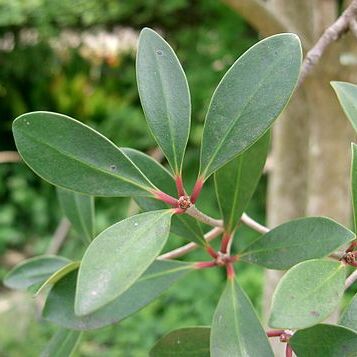Trees or shrubs, the branches ? opposite or verticillate, glabrous. Leaves al-ternate, opposite or subverticillate, usually coriaceous, the margins entire or nearly so. Flowers axillary, usually solitary, I, the bracteoles usually 2, opposite or sub-opposite, mostly inserted immediately beneath the calyx, sepaloid; sepals 5, im-bricate, persistent; petals 5, imbricate, episepalous, distinct or ? connate basally, deciduous; stamens oc, usually 2-seriate, the filaments united at the base and adnate to the corolla, the anthers basifixed, glabrous, usually longer than the fila-ments, the connective usually projected into an apiculate or caudate appendage; ovary superior, usually 2-3-celled, the ovules 2-20 in each cell, pendulous; styles united into one, the stigma entire. Fruits baccate, soft-coriaceous, often crowned by the persistent style, few-seeded, the testa smooth or papillate; endosperm scanty, fleshy; embryo curved.
Evergreen trees. Leaves spirally arranged, simple, subcoriaceous, margins entire. Flowers axillary, hermaphrodite or, more rarely, dioecious (as in the African species). Sepals 5–7. Petals mostly 5, 7–10 in the African species, opposite the sepals or irregularly disposed. Stamens numerous, 1-many-seriate ; connective of anthers often prolonged beyond the thecae. Ovary (reduced in male flowers of dioecious species) (l–)2–3-locular or falsely 4–6-locular ; ovules (l–)2–20 in each loculus. Style very short with stigmas small, conspicuous or sometimes foliaceous. Fruit indehiscent. Seeds ellipsoid, with a thick testa; endosperm usually very reduced, sometimes lacking.

